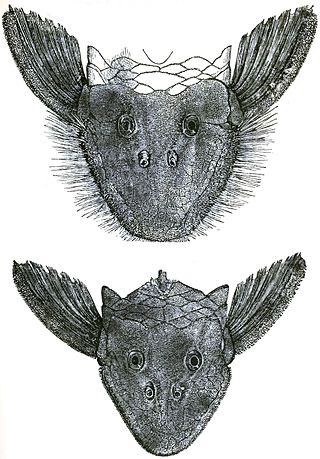
Trichomycteridae is a family of catfishes commonly known as pencil catfishes or parasitic catfishes. This family includes the candiru fish, feared by some people for its alleged habit of entering into the urethra of humans. They are one of the few parasitic chordates. Another species is the life monsefuano which was important to the Moche culture and still an important part of Peruvian cuisine.

Pseudancistrus is a genus of suckermouth armored catfishes native to South America.
Tridensimilis is a genus of pencil catfishes native to South America.
Pseudostegophilus is a genus of pencil catfishes native to rivers in tropical South America. The members of this genus are obligate parasites that feed on scales and mucus of other fish.
Stegophilus is a genus of pencil catfishes native to South America.
Pygidianops is a genus of pencil catfishes native to South America.
Ochmacanthus is a genus of pencil catfishes native to South America. These species are distributed in South America. O. alternus and O. orinoco originate from the Rio Negro and Orinoco River basins of Brazil and Venezuela. O. batrachstoma inhabits the Paraguay River basin in Brazil. O. flabelliferus lives in river drainages in Guyana and Venezuela. O. reinhardtii is known from the Amazon River basin in Brazil and drainages in French Guiana.

Henonemus is a genus of pencil catfishes native to South America.

Aspredo aspredo is the only species of banjo catfish in the genus Aspredo.
Acanthobunocephalus nicoi is one of two species of catfish in the genus Acanthobunocephalus of the family Aspredinidae. This species is known from only three localities and appears to be restricted to the upper Orinoco River system of Venezuela and possibly the upper Rio Negro system of Brazil.
Platystacus cotylephorus, the Banded banjo, is a species of banjo catfish. It is the only member of its genus. The genus Platystacus is the sister group to a clade containing Aspredo and Aspredinichthys. P. cotylephorus originates from coastal waters and lower portions of rivers of northern South America, from Venezuela to northern Brazil.
Aspredinichthys is a genus of banjo catfishes found in fresh and brackish waters in tropical South America from the Orinoco delta, through the Guianas, to the Amazon delta. Both species are found in lower portions of rivers and in coastal waters of northern South America from Venezuela to northern Brazil where they are benthic fish.

Goeldiella eques is a species of three-barbeled catfish that occurs in the Guianas and the Amazon basin of Brazil, Peru and Venezuela. This fish reaches a length of 28.9 centimetres (11.4 in) SL. It is the only species of its genus.
Pseudancistrus coquenani is a species of catfish in the family Loricariidae. It is native to South America, where it occurs in the basin of the Cuquenán River, which itself is part of the upper Caroní River drainage in Venezuela. The species reaches 8.1 cm SL, and it is named for the river basin in which it is found.

Pseudancistrus corantijniensis is a species of catfish in the family Loricariidae. It is native to South America, where it occurs in the Courantyne River in Suriname. The species reaches 17.9 cm SL, and it is named for the Courantyne, which is its only known habitat.
Pseudancistrus kwinti is a species of catfish in the family Loricariidae. It is native to South America, where it occurs in the Coppename River in Suriname. The species reaches 9.4 cm (3.7 in) SL. P. kwinti was described in 2010 by Phil Willink of the Field Museum of Natural History, Jan Mol of Anton de Kom University of Suriname, and Barry Chernoff of Wesleyan University on the basis of distinctive morphology and coloration.
Pseudancistrus orinoco is a species of catfish in the family Loricariidae. It is native to South America, where it occurs in the Orinoco basin. The species reaches 10 cm in total length.
Pseudancistrus yekuana is a species of catfish in the family Loricariidae.
Pseudancistrus pectegenitor is a species of catfish in the family Loricariidae. It is native to South America, where it occurs in the main channel of the Orinoco near the mouth of the Ventuari River, as well as in the Casiquiare. The species is usually found in areas with flowing water near large rocky outcrops. It reaches 24.2 cm SL.
Pseudancistrus reus is a species of catfish in the family Loricariidae. It is native to South America, where it occurs in the Caroní River in Venezuela. It is typically found in presumably blackwater environments with low conductivity and a moderate current. The species reaches 7.7 cm SL. Its specific epithet, reus, is derived from Latin and translates to "prisoner", alluding to the species' barred patterning which resembles a stereotypical prison uniform.





